Fly fishing can seem daunting initially, but with the right knowledge and setup, you can quickly learn to catch trout and other fish. This guide, brought to you by flyermedia.net, provides a comprehensive overview of how to setup a fly rod, including selecting the appropriate rod, line, and reel, mastering essential knots, and choosing the right fly. By understanding fly fishing gear setup and fly fishing rod rigging, you’ll be well-equipped to enjoy this rewarding sport. Learn more about fly fishing techniques and equipment on flyermedia.net today.
1. Setting Up Your Beginner Fly Fishing Rod: A Comprehensive Guide
Setting up a fly fishing rod might seem complex, but breaking it down into manageable steps makes the process straightforward. This guide covers the essential components of a fly fishing setup, helps you choose the right gear for your specific fishing conditions, and provides detailed instructions on how to rig your fly fishing rod correctly.
1.1. Selecting the Right Fly Fishing Rod
Your fly fishing rod is the foundation of your setup. When choosing a rod, consider its length and weight, as these factors significantly impact your casting ability and overall fishing experience.
Fly Fishing Rod Length: The length of your rod is primarily determined by the size of the streams and rivers you’ll be fishing.
- Smaller Streams: Opt for a rod between 7 and 9 feet long.
- Larger Waters: Choose a rod between 10 and 12 feet long.
 Nymphing fly fishing rod with net
Nymphing fly fishing rod with net
Fly Fishing Rod Weight: The weight of your fly fishing rod affects your casting control.
- Comfort: Select a rod that feels comfortable in your hand, ensuring it’s neither too heavy nor too light.
- Fishing Type: Match the rod’s weight to the type of water you’ll be fishing.
According to research from the American Fly Fishing Trade Association (AFFTA), the most popular rod weight for trout fishing is a 5-weight, offering a balance of power and finesse.
| Rod Size (Weight) | Type of Fish |
|---|---|
| 3-4 | Small trout |
| 5 | Average trout/ Typical fly fishing |
| 6-7 | Bass/ Streamer fishing |
| 8-9 | Bass, Pike, Large Trout |
| 10-12 | Tarpon and other large saltwater species. |
1.2. Step 1: Assembling Your Fly Fishing Rod
Assembling your fly fishing rod correctly is crucial for its performance and longevity.
- Butt Section: Start with the butt section, which is the end you hold and where the reel is attached.
- Alignment: Insert the end of the butt section into the next largest section, aligning the dots 180 degrees apart.
- Twist: Twist the sections together to ensure a snug fit.
- Repeat: Repeat this process for all remaining sections.
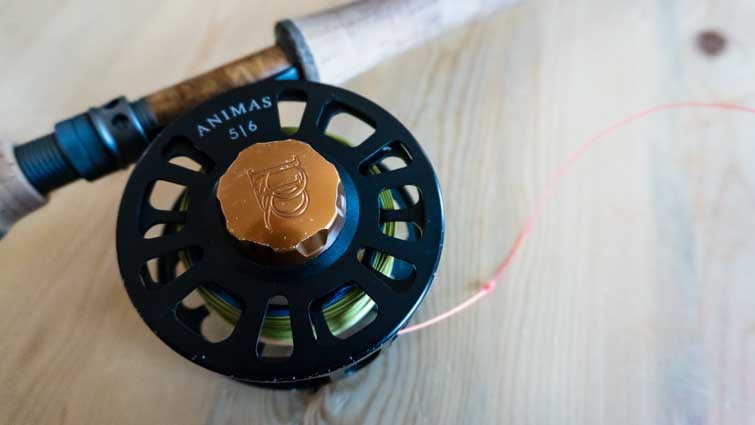 Assembly a fly rod
Assembly a fly rod
1.3. Step 2: Attaching Your Fly Reel
The fly reel is essential for managing your line and fighting fish. Choose a reel that matches the weight of your fly line.
- Heavier Fly Lines: Require a heavier reel.
- Lighter Fly Lines: Work best with a lighter reel.
| Reel Size (Weight) | Type of Fish |
|---|---|
| 3-4 | Small trout |
| 5 | Average trout/ Typical fly fishing |
| 6-7 | Bass/ Streamer fishing |
| 8-9 | Bass, Pike, Large Trout |
| 10-12 | Tarpon/ Large saltwater fish |
- Drag System: Ensure your reel has a reliable drag system for controlled fish fighting.
- Attachment: Locate the cork on the butt section, unscrew the locking nuts, and slide the reel foot underneath.
- Alignment: Ensure the reel is in line with the rod guides.
- Security: Tighten the locking nuts to secure the reel.
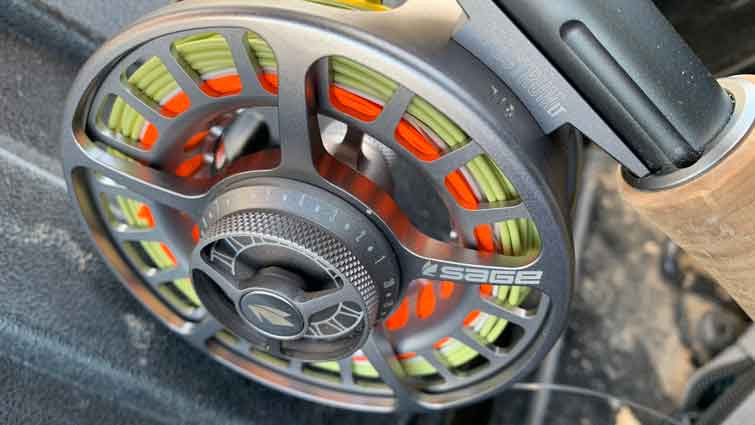 Fly Reel
Fly Reel
1.4. Step 3: Attaching Line Backing
Line backing provides the necessary length for fighting larger fish and prevents your fly line from completely emptying off the reel.
- Weight: The weight of your line backing should be equal to or greater than the weight of your fly line.
- Arbor Knot: Attach one end of the backing to the spool of your reel and the other to your fly fishing rod using an arbor knot.
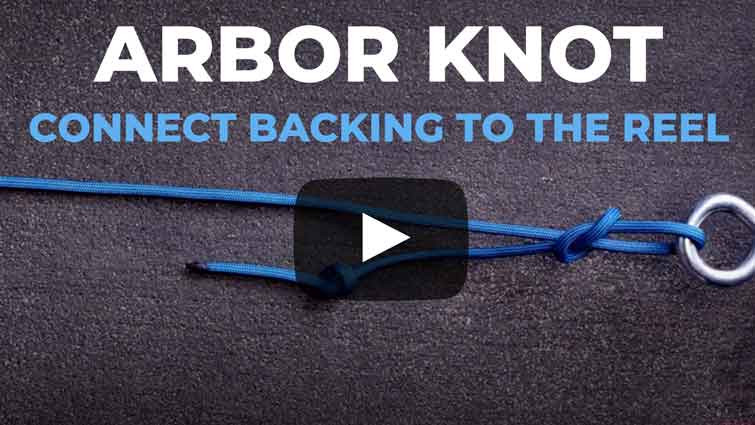 Arbor Knot short video click to watch
Arbor Knot short video click to watch
- Reel Configuration: Ensure the reel is correctly configured for left or right-hand retrieve.
- Spool Attachment: Attach the backing to the spool, which is easier before mounting the reel on the rod.
- Winding: Load the backing onto the reel by winding.
- Amount: Use between 100 and 200 yards of backing, matching the amount to the size of your reel.
- Manufacturer Specifications: Check the manufacturer’s website for your fly fishing reel for specific capacity recommendations.
1.5. Step 4: Attaching Your Fly Line
The fly line is crucial for casting your fly accurately and effectively.
- Surgeons Loop or Albright Knot: Attach the opposite end of the backing to the fly line using a Surgeons Loop (if your fly line has a pre-welded loop) or an Albright Knot (if it does not).
Types of Fly Lines:
- Floating Fly Line: The most versatile type, suitable for most fishing conditions.
- Sinking Fly Line: Ideal for fishing deeper water or targeting heavier fish.
- Sinking Tip Fly Line: A good compromise for fishing in deeper water without using a full sinking line.
 Sinking fly line
Sinking fly line
- Line Weight: Match the line weight to your rod and reel to ensure optimal casting performance.
- Lighter Lines (1-3): Suitable for small fish and trout.
- Medium Lines (4-5): Ideal for panfish and larger trout.
- Heavier Lines (6-7): Best for large trout and bass.
- Very Heavy Lines (8+): Designed for large salmon and saltwater species.
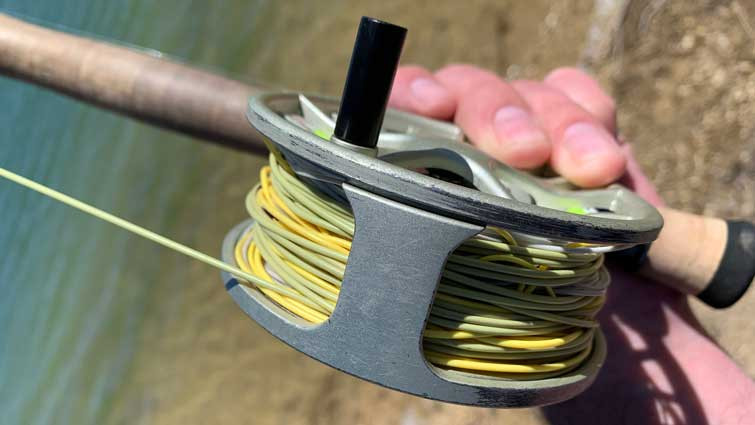 Fly Line on a fly rod
Fly Line on a fly rod
1.5.1. Top or Bottom of the Reel: Which is Best for Fly Line?
The direction in which the fly line comes off the reel can affect your casting and fish-fighting experience.
- Bottom: Fly line should come off the bottom of the reel to ensure enough space between the rod handle and the line for your fingers.
- Finger Clearance: This positioning prevents issues with removing or switching the rod to your other hand when a fish strikes.
1.6. Step 5: Attaching A Leader
The leader connects the fly line to the fly, providing a more subtle presentation to avoid spooking fish.
- Materials: Leaders are typically made of monofilament or fluorocarbon.
- Monofilament: More affordable but more visible in the water.
- Fluorocarbon: Sinks faster and is less visible, making it ideal for wary fish.
- Attachment: Use a loop-to-loop connection or a blood knot to attach the leader to the fly line. Alternatively, a nail knot or snail knot is effective for larger diameter fly lines and leader materials.
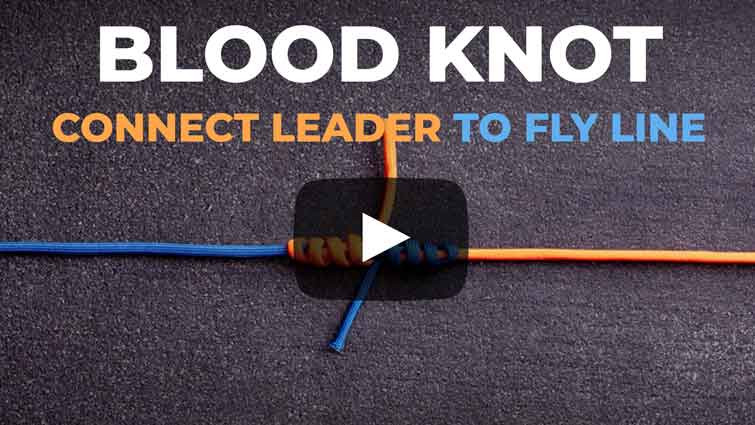 Blood Knot Video – How to Attach Leader to Fly Line
Blood Knot Video – How to Attach Leader to Fly Line
- Length: Leaders range from 6 to 12 feet. A 9-foot tapered leader is a good starting point.
- Loop: Ensure there is a loop at the end of your leader for easy attachment to your fly line.
1.6.1. Do You Need a Tippet and Leader?
The use of a tippet in conjunction with a leader is a common question among fly fishers.
- Tippet Use: You don’t always need a tippet if you have a long enough tapered leader.
- Extending Leader: Tippet is useful for extending your leader or adding length when the leader becomes too short from changing flies.
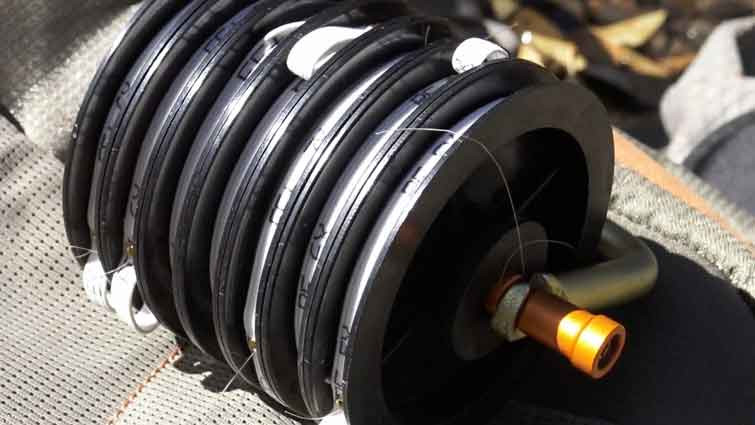 Tippet for fly fishing
Tippet for fly fishing
- Purpose of Tippet: The main purpose of a tippet is to provide a transition between the fly line and the leader, protecting the fly line from damage and acting as a shock absorber.
- Purpose of Leader: The leader helps you cast your fly more effectively.
1.7. Step 6: Attaching Tippet to Your Leader
The tippet is the final section of the leader, connecting directly to the fly.
- Materials: Tippets are made from monofilament or fluorocarbon.
- Monofilament: Strong, flexible, and affordable.
- Fluorocarbon: Nearly invisible in the water and highly abrasion-resistant.
- Knot: Use the double surgeons knot to attach your tippet to your leader. This knot also allows you to add additional tags for multiple flies.
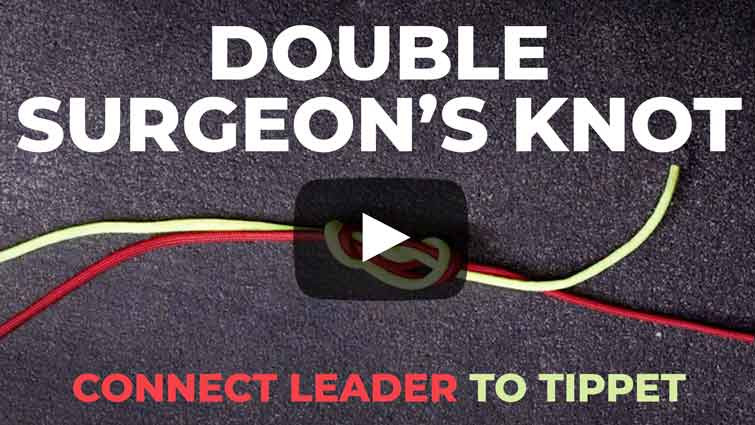 Double Surgeons Knot Fly Fishing Video
Double Surgeons Knot Fly Fishing Video
- Material Choice:
- Monofilament: The most popular choice due to its strength, affordability, and availability.
- Fluorocarbon: Favored for its invisibility but can be more expensive and harder to find.
- Tippet Size: Match the tippet size to the type of catch you are targeting.
| Tippet Size | Diameter | Pounds Test | Fish Size |
|---|---|---|---|
| 03X | .015 inches | 25 pounds | Big Game |
| 02X | .013 inches | 20 pounds | Larger Salmon |
| 01X | .012 inches | 18.5 pounds | Striped Bass |
| 0X | .011 inches | 15.5 pounds | Salmon or Steelhead |
| 1X | .010 inches | 13.5 pounds | Bonefish |
| 2X | .009 inches | 11.5 pounds | Largemouth & Smallmouth Bass |
| 3X | .008 inches | 8.5 pounds | Bass & Larger Trout |
| 4X | .007 inches | 6 pounds | Average Trout |
| 5X | .006 inches | 4.75 pounds | Trout & Panfish |
| 6X | .005 inches | 3.5 pounds | Smaller Trout |
| 7X | .004 inches | 2.5 pounds | Smaller Trout & Panfish |
| 8X | .003 inches | 1.75 pounds | Small Flies |
- Sensitivity: Avoid using a tippet that is too large, as it can decrease the sensitivity of your line.
- Landing Fish: Ensure the tippet is strong enough to handle the fish you intend to catch.
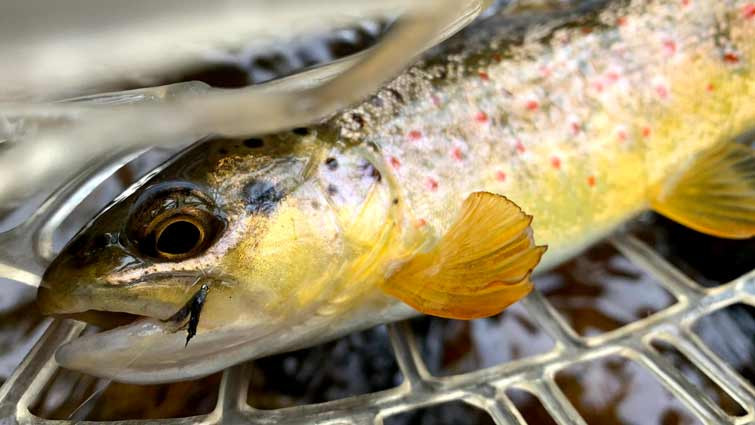 Small fly on tippet in mouth of small fish
Small fly on tippet in mouth of small fish
1.8. Step 7: Attaching Fly to Your Tippet
The final step is attaching the fly to your tippet. Two popular knots for this purpose are the Improved Clinch Knot and the Non-Slip Loop Knot.
- Improved Clinch Knot: Use this knot for your first fly on multiple nymph rigs and dry fly rigs.
- Non-Slip Loop Knot: Use this knot when tying on streamers to allow for extra movement, as well as on tailing droppers and emergers for free movement in the water column.
1.9. How Do You Reel a Fly Rod Effectively?
Reeling a fly rod correctly is vital for landing fish successfully.
- Drag Setting: Ensure your drag isn’t too tight to prevent the line from breaking.
- Rod Tip Position: Keep your rod tip high to maintain pressure on the fish.
- Reeling Technique: Slowly reel in the line. If the fish is low in the water, reel in as much as possible, dip the rod tip, and reel in again as you lift.
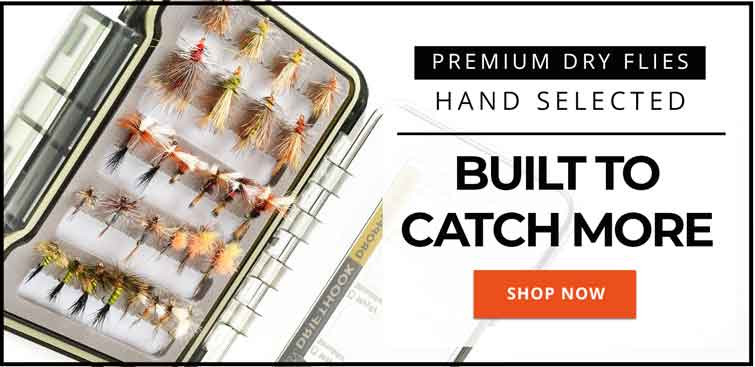 Fly Fishing Flies by Drifthook – Catch more on the water
Fly Fishing Flies by Drifthook – Catch more on the water
2. Fly Fishing Gear Selection: Making Informed Choices
Choosing the right fly fishing gear is critical for a successful and enjoyable experience.
2.1. Understanding Fly Rod Components
A fly rod is composed of several parts, each serving a specific function:
- Rod Blank: The main body of the rod, providing the flex and power for casting.
- Guides: Rings along the rod that guide the fly line.
- Reel Seat: The part of the rod where the reel is attached.
- Grip: The handle, usually made of cork, providing a comfortable hold.
2.2. Fly Reel Essentials
The fly reel is more than just a line holder; it plays a significant role in fighting fish.
- Arbor Size: A larger arbor reel retrieves line faster, which is beneficial when fighting fast-moving fish.
- Drag System: A smooth and reliable drag system is essential for applying consistent pressure to the fish without breaking the line.
- Material: Reels are typically made from aluminum or graphite. Aluminum reels are more durable, while graphite reels are lighter.
2.3. Fly Line Characteristics
The fly line is specialized for fly fishing, designed to carry the lightweight fly through the air.
- Taper: The taper of the fly line affects how it casts and presents the fly. Common tapers include weight-forward (WF), double-taper (DT), and level (L).
- Density: Fly lines are available in different densities, including floating, sinking, and sink-tip, to match various fishing conditions.
- Core: The core of the fly line is typically made of braided nylon or monofilament, providing strength and flexibility.
2.4. Leader and Tippet Materials
Leaders and tippets are crucial for presenting the fly naturally to the fish.
- Monofilament: A common choice for leaders and tippets due to its affordability and all-around performance.
- Fluorocarbon: Virtually invisible underwater, making it ideal for clear water and wary fish.
- Length and Strength: Choose the appropriate length and strength of leader and tippet based on the size of the fish you are targeting and the fishing conditions.
3. Essential Fly Fishing Knots: A Detailed Guide
Mastering essential fly fishing knots is fundamental to a successful fly fishing experience.
3.1. Arbor Knot
The arbor knot is used to attach the backing to the fly reel spool.
- Steps:
- Pass the backing through the reel spool arbor.
- Tie a simple overhand knot in the tag end.
- Tie another overhand knot in the standing line close to the first knot.
- Pull the tag end to tighten the knot against the arbor.
3.2. Albright Knot
The Albright knot is used to connect the fly line to the backing.
- Steps:
- Form a loop in the heavier line (usually the fly line).
- Pass the end of the lighter line (backing) through the loop.
- Wrap the lighter line around the loop and itself several times.
- Pass the end of the lighter line back through the loop.
- Tighten the knot by pulling on both ends.
3.3. Surgeons Loop Knot
The Surgeons Loop knot is used to create a loop in the end of a line, often for loop-to-loop connections.
- Steps:
- Double the line to form a loop.
- Tie a simple overhand knot with the doubled line.
- Pass the loop through the knot again.
- Moisten and tighten the knot.
3.4. Blood Knot
The Blood Knot is used to join two lines of similar diameter, such as sections of leader material.
- Steps:
- Overlap the ends of the two lines.
- Wrap one line around the other several times.
- Bring the end back and tuck it between the two lines.
- Repeat with the other line, wrapping it in the opposite direction.
- Moisten and tighten the knot.
3.5. Improved Clinch Knot
The Improved Clinch Knot is used to attach the fly to the tippet.
- Steps:
- Pass the tippet through the eye of the hook.
- Wrap the tippet around the standing line several times.
- Pass the end of the tippet through the loop closest to the eye.
- Bring it back through the larger loop.
- Moisten and tighten the knot.
3.6. Non-Slip Loop Knot
The Non-Slip Loop Knot creates a loop that allows the fly to move more freely in the water.
- Steps:
- Pass the tippet through the eye of the hook.
- Create a loop and hold it against the standing line.
- Wrap the tippet around the standing line and the loop several times.
- Pass the end of the tippet back through the loop.
- Moisten and tighten the knot.
4. Fly Fishing Techniques: Casting and Presentation
Mastering casting and presentation techniques is essential for enticing fish to strike.
4.1. Basic Casting Techniques
- Overhead Cast: The most common casting technique, involving a back cast and a forward cast.
- Roll Cast: Used when there is limited space for a back cast, involving a smooth, rolling motion of the rod.
- Spey Cast: A more advanced technique used for casting long distances on larger rivers.
4.2. Fly Presentation
Presenting the fly in a natural and enticing manner is crucial for fooling fish.
- Dead Drift: Allowing the fly to drift naturally with the current, without any drag.
- Swinging Flies: Allowing the fly to swing across the current, often used for streamer fishing.
- Stripping Flies: Retrieving the fly with short, jerky movements to imitate a swimming baitfish.
4.3. Reading the Water
Understanding the water conditions and identifying potential fish holding areas is key to success.
- Seams: Areas where fast and slow currents meet, often holding fish waiting for food.
- Pools: Deeper areas of the river, providing cover and shelter for fish.
- Riffles: Shallow, turbulent areas that oxygenate the water and provide habitat for aquatic insects.
5. Fly Selection: Choosing the Right Fly for the Occasion
Choosing the right fly is crucial for matching the hatch and enticing fish to strike.
5.1. Types of Flies
- Dry Flies: Imitate adult aquatic insects that float on the surface of the water.
- Nymphs: Imitate juvenile aquatic insects that live underwater.
- Streamers: Imitate baitfish and other larger prey items.
- Emergers: Imitate aquatic insects as they transition from nymph to adult.
5.2. Matching the Hatch
Observing the insects that are present on the water and selecting a fly that closely imitates them is known as matching the hatch.
- Size: Choose a fly that is similar in size to the natural insects.
- Shape: Select a fly that has a similar shape and profile to the natural insects.
- Color: Choose a fly that is similar in color to the natural insects.
5.3. Fly Fishing Resources on Flyermedia.net
Flyermedia.net provides a wealth of information to help you choose the right fly, including fly patterns, hatch charts, and expert advice.
6. Maintenance and Care of Your Fly Fishing Gear
Proper maintenance and care will extend the life of your fly fishing gear and ensure optimal performance.
6.1. Rod Maintenance
- Cleaning: After each use, clean your rod with a soft cloth to remove dirt and grime.
- Storage: Store your rod in a protective case to prevent damage.
- Inspection: Regularly inspect your rod for cracks, loose guides, or other damage.
6.2. Reel Maintenance
- Cleaning: Rinse your reel with fresh water after each use, especially after saltwater fishing.
- Lubrication: Periodically lubricate the moving parts of your reel with a reel-specific lubricant.
- Storage: Store your reel in a dry place to prevent corrosion.
6.3. Line Maintenance
- Cleaning: Clean your fly line with a line cleaner to remove dirt and grime.
- Conditioning: Apply a line dressing to keep your fly line floating high and casting smoothly.
- Storage: Store your fly line on the reel or in a line spool to prevent tangling.
7. Safety Tips for Fly Fishing
Fly fishing can be a safe and enjoyable activity when practiced with caution and awareness.
7.1. Wading Safety
- Wading Boots: Wear wading boots with felt or rubber soles for traction on slippery rocks.
- Wading Staff: Use a wading staff for added stability in fast-moving water.
- Awareness: Be aware of your surroundings and avoid wading in dangerous areas.
7.2. Hook Safety
- Barbless Hooks: Consider using barbless hooks to make hook removal easier and less harmful to fish.
- Eye Protection: Wear sunglasses or safety glasses to protect your eyes from flying hooks.
- First Aid Kit: Carry a small first aid kit with you in case of hook injuries.
7.3. Weather Awareness
- Check the Forecast: Check the weather forecast before heading out to fish.
- Lightning: Seek shelter immediately if you see lightning.
- Hypothermia: Dress in layers and be prepared for cold weather conditions.
8. Frequently Asked Questions (FAQ) About Setting Up a Fly Rod
8.1. What is the best weight fly rod for beginners?
A 5-weight fly rod is generally considered the best all-around option for beginners due to its versatility in handling various fly sizes and fishing conditions.
8.2. How do I choose the right fly line for my rod?
Match the fly line weight to the rod weight. A 5-weight rod should be paired with a 5-weight fly line.
8.3. What is the purpose of line backing?
Line backing provides extra line capacity on your reel, allowing you to fight larger fish that may run long distances.
8.4. How long should my leader be?
A 9-foot leader is a good starting point for most trout fishing situations.
8.5. What is the difference between monofilament and fluorocarbon leaders?
Monofilament is more affordable and has good all-around performance, while fluorocarbon is virtually invisible underwater and has higher abrasion resistance.
8.6. How do I attach the fly line to the backing?
Use an Albright knot to securely connect the fly line to the backing.
8.7. What is the best knot for attaching a fly to the tippet?
The Improved Clinch Knot is a reliable and easy-to-tie knot for attaching a fly to the tippet.
8.8. How often should I clean my fly line?
Clean your fly line every few fishing trips or whenever it becomes dirty or coated with grime.
8.9. What is the purpose of a tippet?
A tippet is a section of line that connects the leader to the fly, providing a fresh, invisible section of line that is replaced when changing flies.
8.10. How do I prevent my fly line from tangling?
Properly spool your fly line onto the reel, avoid overfilling the reel, and use a line dressing to keep the line smooth and supple.
9. Exploring Further with Flyermedia.net: Your Gateway to Aviation and Beyond
Assembling and setting up your first fly rod may seem challenging initially, but with this guide, you’re now equipped with the knowledge to approach it with confidence. Remember, selecting the materials that suit your catch and the conditions is key. While there are many products on the market designed to simplify the process for beginners, diving deeper into the specifics of rods, reels, and unique setups will greatly enhance your fly fishing style.
Ready to take your passion for fly fishing further? Visit flyermedia.net, where you’ll find a wealth of information and resources to help you excel in this rewarding sport.
But flyermedia.net offers more than just fly fishing tips. If you’re fascinated by aviation, explore our extensive coverage of flight training, pilot careers, and the latest advancements in aviation technology.
9.1. Discover Aviation Opportunities
Dreaming of becoming a pilot? Flyermedia.net provides a comprehensive guide to flight schools in the USA, including top-rated institutions like Embry-Riddle Aeronautical University (Address: 600 S Clyde Morris Blvd, Daytona Beach, FL 32114, United States, Phone: +1 (386) 226-6000). Whether you’re interested in commercial aviation, private flying, or aviation maintenance, our resources will help you navigate your path to the skies.
9.2. Stay Informed with Aviation News
Keep up-to-date with the latest news and trends in the aviation industry. From new aircraft designs to regulatory changes and safety updates, flyermedia.net delivers timely and accurate information to keep you informed.
9.3. Explore Aviation Careers
Discover a wide range of career opportunities in aviation, from pilots and air traffic controllers to aircraft mechanics and aviation managers. Learn about the required qualifications, training programs, and job prospects in this dynamic field.
Ready to take the next step? Visit flyermedia.net today to explore the world of aviation and discover the resources you need to achieve your dreams. Whether you’re passionate about fly fishing or aviation, flyermedia.net is your trusted source for information and inspiration.
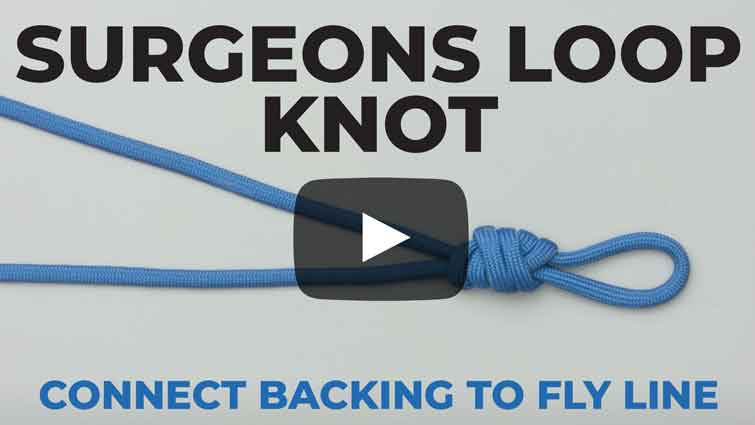 Surgeons Loop Knot – Video
Surgeons Loop Knot – Video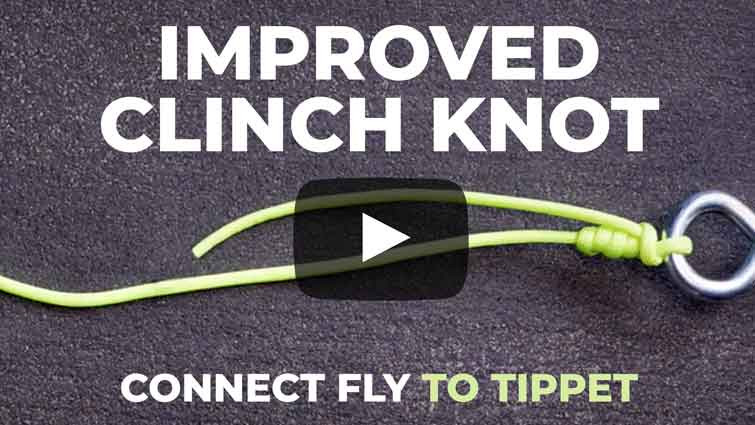 Improved Clinch Knot Video
Improved Clinch Knot Video Non Slip Loop Knot Video
Non Slip Loop Knot Video